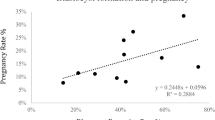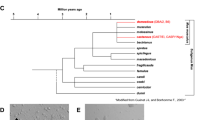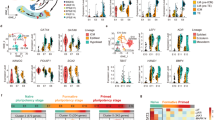Abstract
NUCLEAR transfer has been used in mammals as both a valuable tool in embryological studies1 and as a method for the multiplication of 'elite' embryos2–4. Offspring have only been reported when early embryos, or embryo-derived cells during primary culture, were used as nuclear donors5,6. Here we provide the first report, to our knowledge, of live mammalian offspring following nuclear transfer from an established cell line. Lambs were born after cells derived from sheep embryos, which had been cultured for 6 to 13 passages, were induced to quiesce by serum starvation before transfer of their nuclei into enucleated oocytes. Induction of quiescence in the donor cells may modify the donor chromatin structure to help nuclear reprogramming and allow development. This approach will provide the same powerful opportunities for analysis and modification of gene function in livestock species that are available in the mouse through the use of embryonic stem cells7.
This is a preview of subscription content, access via your institution
Access options
Subscribe to this journal
Receive 51 print issues and online access
$199.00 per year
only $3.90 per issue
Buy this article
- Purchase on SpringerLink
- Instant access to full article PDF
Prices may be subject to local taxes which are calculated during checkout
Similar content being viewed by others
References
McGrath, J. & Solter, D. Science 220, 1300–1302 (1983).
Bondioli, K. R., Westhusin, M. E. & Looney, C. R. Therio 33, 165–174 (1990).
Prather, R. S. & First, N. L. Int. Rev. Cytol. 120, 169–190 (1990).
Chesne, P., Heyman, Y., Peynot, N. & Renard, J.-P. C.r. Acad. Sci. Paris Life Sci. 316, 487–491 (1993).
Sims, M. & First, N. L. Proc. natn. Acad. Sci. U.S.A. 91, 6243–6147 (1994).
Collas, P. & Barnes, F. L. Molec. Repr. Dev. 38, 264–267 (1994).
Hooper, M. L. Embryonal Stem Cells: Introducing Planned Changes into the Germline (ed. Evans, H. J.) (Harwood Academic, Switzerland, 1992).
Galli, C., Lazzari, G., Flechon, J. & Moor, R. M. Zygote 2, 385–389 (1994).
Campbell, K. H. S., Ritchie, W. A. & Wilmut, I. Biol. Reprod. 49, 933–942 (1993).
Campbell, K. H. S., Loi, P., Capai, P. & Wilmut, I. Biol. Reprod. 50, 1385–1393 (1994).
Szollosi, D., Czolowska, R., Szollosi, M. S. & Tarkowski, A. K. J. Cell Sci. 91, 603–613 (1988).
Whitten, W. K. & Biggers, J. D. J. Reprod. Fertil. 17, 399–401 (1968).
Breslaw, N. E. & Clayton, D. G. J. Am. Stat. Assoc. 88, 9–25 (1993).
Whitfield, J. F., Boynton, A. L., Rixon, R. H. & Youdale, T. Control of Animal Cell Proliferation Vol. 1 (eds Boynton, A. L. & Leffert, H. L.) 331–365 (Academic, London 1985).
Piedrahita, J. A., Anderson, G. B. & Bon Durrant, R. H. Therio 34, 879–901 (1990).
Gerfen, R. W. & Wheeler, M. B. Anim. Biotechnol. 6, 1–14 (1995).
Willadsen, S. M. Nature 320, 63–65 (1986).
Buchanan, F. C., Galloway, S. M. & Crawford, A. M. Anim. Genet. 25, 60 (1994).
Author information
Authors and Affiliations
Rights and permissions
About this article
Cite this article
Campbell, K., McWhir, J., Ritchie, W. et al. Sheep cloned by nuclear transfer from a cultured cell line. Nature 380, 64–66 (1996). https://doi.org/10.1038/380064a0
Received:
Accepted:
Issue Date:
DOI: https://doi.org/10.1038/380064a0
This article is cited by
-
A review of transgenic animal techniques and their applications
Journal of Genetic Engineering and Biotechnology (2023)
-
Sir Ian Wilmut 1944–2023
Nature Biotechnology (2023)
-
Self-organization defines some of the earliest determinants of embryonic development
Journal of Assisted Reproduction and Genetics (2023)



